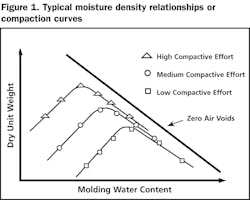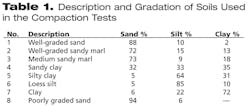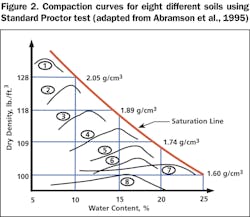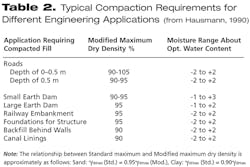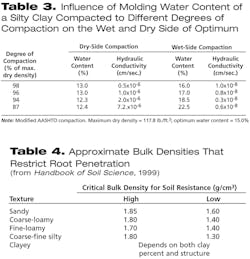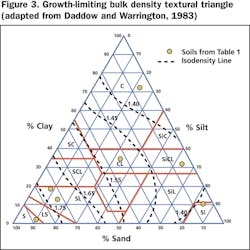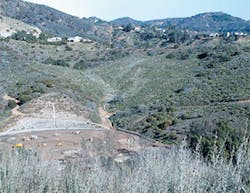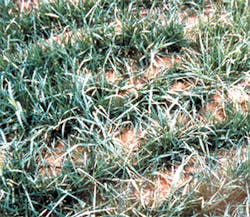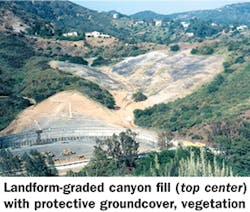Optimizing Soil Compaction and Other Strategies
A conflict appears to exist between engineering requirements to compact soil to a high density to improve its engineering properties—such as increased strength and decreased compressibility—and agronomic needs to maintain soil in a relatively loose condition to improve its ability to support vegetation. This conflict or contradiction, while real, has been misunderstood and overstated. The objectives of compaction from an engineering perspective have frequently been obscured in a manner that makes accommodation for plant-growth needs more difficult to achieve. Furthermore, vegetation can be grown successfully in compacted soil under less-than-ideal conditions provided certain limits and precautions are observed.
The purpose of this article is to present information that can help engineers and other professionals make decisions regarding soil compaction so as to balance plant-growth needs with engineering requirements. This balance is essential to successful installation and implementation of vegetative and soil bioengineering stabilization treatments. Several approaches can be invoked that make it possible to compact a soil to a relatively high density while still allowing it to support a vegetative cover. In addition, a number of other strategies can be invoked to allow both engineering and plant-growth needs to coexist.
Purpose of Compaction
Compaction can be defined as a process of densification due to the removal of air voids when external stress is applied to a soil. The purpose of compaction from an engineering viewpoint is not to increase soil density. An increase in soil density is a result or consequence of compaction but not the goal. Density is used as a target in engineering soil compaction specifications, but so are molding water content, type of compaction, additives, and compactive effort. The purpose of compaction is to change engineering properties of a soil in a desirable direction. Relevant engineering or physical properties include strength, compressibility, volume stability (shrink-swell potential), hydraulic conductivity, and erodibility. In general, these properties change in a favorable direction with an increase in soil density. There are important exceptions, however: (1) swelling (heave) in clay soils tends to increase at higher densities, and (2) strength can decrease significantly in compacted wet clay soils of optimum to high densities (a phenomenon referred to as “overcompaction”).
The effects of soil compaction on soil strength, compressibility, hydraulic conductivity, and volume stability have been investigated thoroughly (Lambe and Whitman 1969; Seed and Chan 1959). In addition, a series of standardized testing procedures and methods for specifying compaction has become widely adopted. R.R. Proctor developed one of the earliest and still most widely used tests, the Standard Compaction Test, in the 1930s. The procedure involves compacting soil in a standardized mold using a 5.5-pound hammer dropped 25 times from a height of 12 inches. More recently, a so-called Modified Compaction Test was developed that uses a higher specific energy input (approximately four times the Standard Compaction Test effort) to simulate more closely the compactive effort that can be achieved with modern compaction plants. The density that can be achieved using this fixed energy of compaction depends on both the textural composition of the soil and its moisture content at the time of the test. Figure 1 shows a typical compaction curve, or moisture density relationship. Densities are normally expressed in terms of dry unit weight, the dry weight of solids per unit volume. The dry density is related to the moist unit weight or density by the following equation:
Higher densities are achieved when soil particles pack closer together. The maximum density occurs at the so-called optimum water content, which varies with the type of soil and compactive effort. At optimum, the lubrication effect of the mix water allows soil particles to become more easily realigned during the compaction procedure, and this results in the closer packing and higher density. At yet higher moisture contents, the lubrication effect is offset by dilution, and dry density decreases. For any given textural composition of soil and compactive effort, there is a maximum dry density that can be achieved at the optimal moisture level as shown schematically in Figure 1.
Actual compaction curves for different types of soils using the Standard AASHTO (Proctor) test are shown in Figure 2. The classification/composition of these soils is described in Table 1. In general, compacted granular soils have dry densities ranging from 115 to 135 lb/ft3, versus those of clayey to silty soils, which range from 85 to 115 lb/ft3 The corresponding optimum moisture contents are on the order of 10% to 12% for granular soils and 15% to 20% for silty to clayey soils compacted by the Standard Proctor test as shown in Figure 2.
Maximum density does not represent a soil with no void space remaining but rather one where the tightest possible packing arrangement is achieved for the given compaction conditions. The point of 100% saturation is called the “saturation line,” or “zero air voids” curve (Figure 1). This condition cannot be reached unless the soil is completely saturated to begin with and is seldom, if ever, achieved during conventional compaction operations.
As a general rule in engineering practice, earthen fills that are part of site grading and not related to load bearing are specified to be compacted to 90% of Standard Proctor maximum dry density. Load-bearing soils and other specialized fill applications call for higher compaction levels, including compactions that exceed the values achieved by the Standard Proctor test. Typical compaction requirements (dry densities) for various engineering applications are summarized in Table 2.
Engineering Properties of Compacted Soil
Key variables affecting engineering soil properties during compaction include the following:
- Density (usually expressed in terms of “dry” unit weight)
- Water content (molding or mix water content during compaction)
- Compactive effort (energy input per unit volume of soil)
- Type of compaction (static, dynamic, or kneading)
- Additives (cement, lime, etc.)
The degree of saturation or water content of a clay soil at the time of compaction is perhaps the single most important variable that controls the engineering properties of the compacted material (Lambe 1958). The influence of molding water content and compactive effort on hydraulic conductivity of compacted silty clay soil is shown in Table 3. Soils compacted at water contents less than optimum (dry of optimum) tend to have a relatively high hydraulic conductivity, whereas soils compacted at water contents greater than optimum (wet of optimum) tend to have a relatively low hydraulic conductivity. Higher molding water contents also greatly suppress hydraulic conductivity on the wet side of optimum, even offsetting the effect of decreased dry densities (or higher void ratios).
The results shown in Table 3 demonstrate that a soil compacted to the same degree of compaction on the wet side of optimum using the same compaction method but at different molding water contents can have radically different physical properties. This occurs because a soil compacted wet versus dry of optimum (see Figure 1) usually has a different texture or internal pore structure and pore-size distribution. Soils compacted on the dry side of optimum water content tend to have a more open structure and greater distribution of larger pores. Accordingly, dry-side compaction can result in hydraulic conductivities several orders of magnitude higher than wet-side compaction, even when the soil is compacted to identical densities or degrees of compaction (see Table 3). This fact should always be borne in mind when assessing optimal compaction conditions to satisfy plant growth needs versus engineering requirements.
Influence of Soil Compaction on Plant Growth
Soil compaction can influence plant growth in a variety of ways, both good and bad. Agronomists generally recommend minimal soil compaction so as not to impede growth and development of crops and native plants. Soil must retain enough interconnected void space to allow storage and passage of air and water in the soil. Some degree of compaction is needed after planting or insertion of cuttings to close large voids and to provide suitable soil density for appropriate plant growth. Too much void space can lead to poor contact and desiccation of a seed or cutting from the surrounding soil.
The impacts of compaction have been studied extensively by agronomists who are concerned with the decline in soil productivity associated with modern agriculture, forestry practices, and the passage of equipment, which tend to compact soils over time. Goldsmith et al. (2001) provide a good review of these impacts upon both conventional plantings and soil bioengineering installations. In general, findings show that high densities specified by engineers for mechanical strength tend to either reduce or effectively stop the development of roots. Depending on the plant species and the soil conditions, Goldsmith et al. cite evidence of limits to growth that include (1) restriction in root growth, (2) severe reduction in length of all roots or the primary root, and (3) absence of root penetration of compacted soils. These authors conclude that a limiting, or “threshold,” bulk density appears to exist for each soil type or texture above which plant growth is severely curtailed. They further suggest that these limiting densities may be used as a predictive or management tool.
Growth-Limiting Bulk Densities for Plants
Several studies appear to support the concept of a growth-limiting bulk density (GLBD) for a given soil texture or type. Daddow and Warrington (1983) computed GLBDs for 80 different soil textures using a regression equation. They next plotted the GLBDs on a US Department of Agriculture (USDA) soil textural triangle in order to locate the growth-limiting isodensity lines as shown in Figure 3.
Other researchers have tried to relate bulk density to such factors as root penetration, soil strength, and compaction (Table 4). As noted previously, well-graded, noncohesive soils tend to reach higher maximum dry densities than do cohesive soils. Additionally, noncohesive soils exhibit higher critical dry densities than cohesive soils do. Coppin and Richards (1990) concur that the critical dry density depends on the soil texture and suggest values of about 87 lb/ft for clay soils and 106 lb/ft for sandy soils. These threshold values are within the intervals presented in Table 4.
Clays contain more pore space than sandy soils but have a much smaller average pore size. The pore-size distribution controls water transmission, not total porosity. Sandy soils have large pores, and clays have small pores, which transmit water slowly. Soils with small pores, however, retain and hold moisture more effectively. Optimal conditions occur when there are enough large pores to transmit water readily but also enough small pores to retain and store water. Therefore, plants do better in well-compacted, uniform, sandy soils with relatively low porosity (high relative density) or in well-graded sands where sufficient fines (silts and clays) are present to provide moisture retention. The converse is true for clays. High-porosity (low relative density) clay soils allow better infiltration and water transmission to plants than do highly compacted (high relative density) clay soils while at the same time providing good moisture retention and storage. It is critical to emphasize again the importance of compaction on soil structure and pore-size distribution in clay soils. Remember that compaction on the wet side of optimum can reduce hydraulic conductivity (and water transmission) of a clay soil by several orders of magnitude, even when the soil is compacted to the same dry density or relative degree of compaction.
Taken as a whole, findings in the literature seem to suggest that compaction between 80% and 85% of the Standard Proctor maximum dry density provides many of the stabilizing benefits of soil compaction without jeopardizing the viability of vegetation development and growth. GLBDs or critical dry bulk densities can readily be compared to Standard Proctor maximum dry densities. The critical dry density for each type of soil presented in Table 1 and Figure 2 can be determined by plotting the soils in Figure 3. The degree of compaction suitable for root growth is calculated by dividing the critical dry density by the maximum dry density for each type of soil. Compaction rates thus calculated corresponding to GLBDs vary from 82% to 91% of Standard Proctor densities, with an average of 84% (Goldsmith et al. 2001).
fill project (right, center of photo) in
Hollywood Hills
This limit can vary, however, depending on particular soil and site conditions. For example, Horst Schor (1980, 1992), who has pioneered and developed “landform grading” as a way of building stable and visually attractive slopes, has specified and successfully revegetated fill slopes compacted to 90% relative compaction. His canyon fill project above the Hollywood, CA, reservoir is a good example. Slope revegetation at this location has established itself and flourished on soil compacted to 90% of Standard Proctor, as shown in the photo (Figure 4). Schor actually specified overbuilding and then scaling back the slope surface to ensure achieving this degree of compaction. Part of the reason for the revegetation success lies in the shape and topography of the slopes (he eschews planar, uniform slopes). He also pays careful attention to drainage and matching the type of vegetation used to its position and location on the slope.
Balancing Plant Growth and Engineering Stability Needs
Limiting the density increase or degree of compaction to some predetermined threshold value is certainly an important strategy for balancing plant growth and engineering stability requirements. Other strategies, however, can be invoked as well. Furthermore, as explained previously, it is not only density and degree of compaction that determine water transmission character of a clay soil. Other strategies include control of molding water content during compaction, surface modification, soil blending, surface amendments, and topographic modification (landform grading and revegetation).
Controlling Molding Water Content
Soils compacted on the dry side of optimum water content tend to have a more open structure and greater distribution of larger pores. Dry-side compaction can result in hydraulic conductivities several orders of magnitude higher than wet-side compaction, even for two identical soils compacted to an identical dry density or relative degree of compaction. In addition, static compaction, which introduces less shear strain than kneading (or impact compaction) and results in less remolding of soil pore structure, also results in higher hydraulic conductivity and better water transmission. Accordingly, just as much attention should be paid to the manner of compaction than simply the relative degree of compaction if the goal is to maximize plant growth and achieve engineering stability.
Surface Modification
cleat indentations on a slope surface
track walked with a bulldozer
Better plant establishment and initial growth can be achieved if the soil surface is mechanically modified either by contour furrowing, scarification, disking, track walking, pitting, ripping, chiseling, or land imprinting. These treatments transform smooth, sealed soil surfaces with low infiltration rates into micro-rough, macro-porous surfaces that are better able to exchange water and air rapidly across the air-earth interface. They tend to loosen the surface layers and provide small indentations where seed and water can collect, thus aiding germination and establishment. Descriptions and specifications for these various mechanical treatments have been issued by the Natural Resources Conservation Service (USDA 2000). The photo (Figure 5) shows an example of grass establishment and growth in cleat indentations formed by track walking using a bulldozer. Track walking also helps anchor mulch that is applied to the surface. Scarification, ripping, and so on loosen and initially increase the risk of some surficial erosion and sloughing, but this initial risk must be weighed against better long-term protection that is afforded by a vigorous, well-established vegetative cover. Furthermore, initial surficial erosion can be minimized or controlled by the use of hydraulically applied soil binders, fiber mulches, erosion control blankets, and such soil bioengineering treatments as the use of live fascines (Gray and Sotir 1996).
Soil Blending and Artificial Gradation
Soil blending entails adding coarse, noncohesive particles to a soil to improve water transmission properties, allow densification, and still permit good plant growth. Arborists who have to confront the contradictory demands of plant growth versus engineering stability have often resorted to this approach. Street trees are usually grown in soil that must be compacted to a high degree to provide stability to adjoining sidewalks, roadways, and buildings. This same soil must be capable of accommodating growth, very often under less-than-ideal conditions. One way around this problem is to use a type of soil referred to as “structural” soil. This type of soil allows the granular portion to be compacted to a high relative density while providing enough pore space to accommodate needed fines and plant roots in the intergranular voids. Mitchell (1993) describes ways of actually computing the relative proportions of granular solids and fines (clay and silt) to achieve this goal.
Specially formulated soil mixes can also be added atop the surface not only to improve plant growth and establishment but also to minimize runoff and erosion. A good example is the recent development of an organic-based soil (Durant 2001) that mimics the texture and microbiology of native topsoil at depths of 12 to 36 inches and remains stable on 1:1 slopes or steeper. This soil mix is reported to have not eroded, rilled, or slumped during test simulations with intense rainfall on steep slopes. The organic soil mix contains the necessary bacteria, fungi, and mycorrhizae to promote vigorous plant growth and help modify the underlying compacted mineral soil and make it more hospitable to plant growth in the long run.
Landform grading (Schor 1992; Schor and Gray 1995) entails modifying surface topography and drainage so that slopes are stable against erosion and mass wasting. Landform grading mimics stable natural slopes. Vegetation is selected and planted in such a way that it is compatible with hillside hydrogeology. Grasses and groundcovers are planted in drier, convex-shaped slopes or interfluves, while trees and shrubs are planted in wetter, concave-shaped valleys, swales, and depressions. Careful attention is applied to drainage, which follows natural drop lines on a slope in a manner that minimizes gradients. Even if soil conditions per se are not entirely favorable to plant growth and establishment, at least all other site conditions are favorable. The photos (Figures 6 and 7) show a landform-graded canyon fill project. Despite of relatively high soil compaction, vegetation has become well established at this site.


